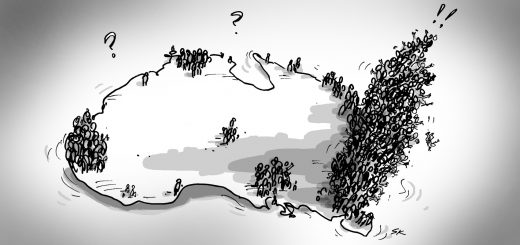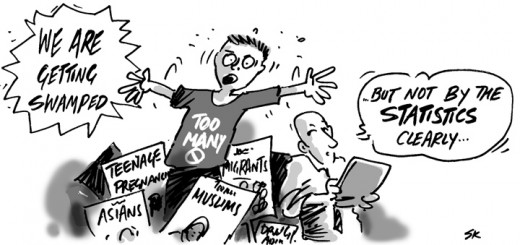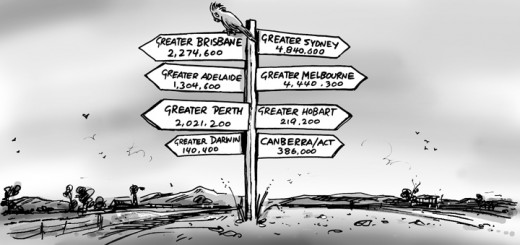The 50 largest cities in Australia | 2021 update
An updated (pandemic edition) of this blog has been published. See the 2022 table of Australia’s largest cities here.
In this update of our ever-popular blog series, Glenn looks largest urban centres in Australia based on the latest population estimates to June 2020. Everyone loves a ranking and here you can see the how Australia’s main urban areas stack up. The big news: Melbourne has overtaken Sydney!
Every year we get an update on local populations, which goes onto our Community Profile (profile.id) sites. Total population is the simplest demographic characteristic but also the most eagerly awaited. As part of this update, the ABS defines “Significant Urban Areas”, which allow us to re-rank Australia’s cities.
While Australia’s population growth slowed down in 2019-20, it didn’t stop. It probably will stop in 2021 – we have preliminary estimates at a national level which show negative growth for the September quarter 2020 – but much of 2019-20 was pre-COVID and the borders were still open.
Top 50 largest cities in Australia
| 5 year change | 1 year change | |||||
| Rank | Significant Urban Area | 2020 pop | no. | % | no. | % |
| 1 | Melbourne Vic | 4,969,305 | 545,542 | 12.3% | 74,522 | 1.5% |
| 2 | Sydney NSW | 4,966,806 | 419,479 | 9.2% | 54,475 | 1.1% |
| 3 | Brisbane Qld | 2,475,680 | 235,474 | 10.5% | 45,873 | 1.9% |
| 4 | Perth WA | 2,083,645 | 119,247 | 6.1% | 36,597 | 1.8% |
| 5 | Adelaide SA | 1,357,504 | 62,523 | 4.8% | 15,997 | 1.2% |
| 6 | Gold Coast – Tweed Heads Qld/NSW | 709,495 | 78,675 | 12.5% | 15,917 | 2.3% |
| 7 | Newcastle – Maitland NSW | 498,015 | 26,532 | 5.6% | 6,613 | 1.3% |
| 8 | Canberra – Queanbeyan ACT/NSW | 464,995 | 32,256 | 7.5% | 3,285 | 0.7% |
| 9 | Sunshine Coast Qld | 348,343 | 38,721 | 12.5% | 7,318 | 2.1% |
| 10 | Central Coast NSW | 337,284 | 12,188 | 3.7% | 1,860 | 0.6% |
| 11 | Wollongong NSW | 309,345 | 17,658 | 6.1% | 3,356 | 1.1% |
| 12 | Geelong Vic | 282,412 | 35,246 | 14.3% | 6,608 | 2.4% |
| 13 | Hobart Tas | 219,071 | 13,900 | 6.8% | 2,301 | 1.1% |
| 14 | Townsville Qld | 183,322 | 6,416 | 3.6% | 1,663 | 0.9% |
| 15 | Cairns Qld | 155,340 | 7,737 | 5.2% | 1,402 | 0.9% |
| 16 | Toowoomba Qld | 139,526 | 6,994 | 5.3% | 1,314 | 1.0% |
| 17 | Darwin NT | 133,268 | 2,171 | 1.7% | -220 | -0.2% |
| 18 | Ballarat Vic | 109,533 | 9,871 | 9.9% | 1,881 | 1.7% |
| 19 | Bendigo Vic | 102,499 | 8,464 | 9.0% | 1,509 | 1.5% |
| 20 | Albury – Wodonga NSW/Vic | 96,075 | 6,769 | 7.6% | 1,248 | 1.3% |
| 21 | Launceston Tas | 89,178 | 3,621 | 4.2% | 971 | 1.1% |
| 22 | Mackay Qld | 80,926 | – 184 | -0.2% | 664 | 0.8% |
| 23 | Rockhampton Qld | 79,602 | 493 | 0.6% | 524 | 0.7% |
| 24 | Melton Vic | 75,517 | 16,485 | 27.9% | 3,325 | 4.6% |
| 25 | Bunbury WA | 75,155 | 1,679 | 2.3% | 539 | 0.7% |
| 26 | Coffs Harbour NSW | 73,018 | 3,779 | 5.5% | 489 | 0.7% |
| 27 | Bundaberg Qld | 71,554 | 1,398 | 2.0% | 254 | 0.4% |
| 28 | Wagga Wagga NSW | 56,887 | 1,528 | 2.8% | 221 | 0.4% |
| 29 | Hervey Bay Qld | 55,975 | 3,546 | 6.8% | 642 | 1.2% |
| 30 | Shepparton – Mooroopna Vic | 52,529 | 2,368 | 4.7% | 424 | 0.8% |
| 31 | Mildura – Wentworth Vic/NSW | 52,319 | 1,739 | 3.4% | 141 | 0.3% |
| 32 | Port Macquarie NSW | 49,478 | 3,680 | 8.0% | 760 | 1.6% |
| 33 | Gladstone – Tannum Sands Qld | 45,938 | 306 | 0.7% | 306 | 0.7% |
| 34 | Tamworth NSW | 43,251 | 1,669 | 4.0% | 71 | 0.2% |
| 35 | Traralgon – Morwell Vic | 42,440 | 1,315 | 3.2% | 196 | 0.5% |
| 36 | Bowral – Mittagong NSW | 40,964 | 3,037 | 8.0% | 560 | 1.4% |
| 37 | Orange NSW | 40,888 | 1,666 | 4.2% | 91 | 0.2% |
| 38 | Warragul – Drouin Vic | 40,645 | 6,392 | 18.7% | 1,429 | 3.6% |
| 39 | Busselton WA | 40,326 | 3,460 | 9.4% | 700 | 1.8% |
| 40 | Dubbo NSW | 39,054 | 2,339 | 6.4% | 293 | 0.8% |
| 41 | Nowra – Bomaderry NSW | 38,314 | 2,114 | 5.8% | 482 | 1.3% |
| 42 | Bathurst NSW | 37,545 | 2,171 | 6.1% | 359 | 1.0% |
| 43 | Geraldton WA | 37,256 | – 1,449 | -3.7% | -7 | 0.0% |
| 44 | Warrnambool Vic | 35,887 | 1,520 | 4.4% | 365 | 1.0% |
| 45 | Albany WA | 34,587 | 820 | 2.4% | 212 | 0.6% |
| 46 | Devonport Tas | 30,877 | 1,002 | 3.4% | 248 | 0.8% |
| 47 | Mount Gambier SA | 29,946 | 541 | 1.8% | 180 | 0.6% |
| 48 | Kalgoorlie – Boulder WA | 28,911 | – 2,608 | -8.3% | -431 | -1.5% |
| 49 | Lismore NSW | 28,495 | – 616 | -2.1% | -76 | -0.3% |
| 50 | Nelson Bay NSW | 28,490 | 1,353 | 5.0% | 217 | 0.8% |
Melbourne overtakes Sydney (depending on your point of view)
Melbourne has overtaken Sydney to become Australia’s largest city!
The big proviso is that, as always, this list is based on “Significant Urban Areas”. These areas are based on an aggregate of SA2s, which contain the continuous urban extent of a city without major gaps. This differs from “Greater Capital Cities”, which are used as benchmarks in most of the .id sites and at the ABS. Greater Capital Cities are defined as broader labour market regions and extend further into rural districts within commuting distance of the capitals.
- This is the first time Melbourne has overtaken Sydney since Significant Urban Areas were defined.
- This has only happened when measuring the contiguous urban area. Using the labour-market definition of Greater Capital Cities, Sydney is still more populous by over 200,000. However Melbourne has been closing the gap there significantly too. Both cities are over 5 million by this measure. It’s still a big deal that our largest city is now Melbourne, when measured by urban extent (and I haven’t seen this mentioned in the media – the ABS didn’t really publicise this fact).
- The reason for the difference is that Sydney’s labour market (Greater City definition) includes the Central Coast (Australia’s 10th largest urban centre). This area is separated geographically by the Hawkesbury River and national parks from the rest of Sydney, so it is excluded on a Significant Urban Area basis.
- Based on current growth rates, it would take another 9 years (so, 2029) for Melbourne to overtake Sydney on a Greater Capital City basis. Of course with population decline in Australia likely from 2021, this could change dramatically.
Some other takeaways
- There are no new entries or dropouts from the previous year – the 50 cities are the same as they were a year ago, and indeed 3 years ago.
- Aside from the big Melbourne vs Sydney story, there are a few reshuffles in the pecking order this year.
- Melton – a big growth area on the outskirts of Melbourne, which is part of the Melbourne Greater Capital City, but a separate Significant Urban Area – rises 2 places to #24.
- Shepparton-Mooroopna overtakes Mildura-Wentworth to #30.
- Bowral-Mittagong in the NSW Southern Highlands overtakes Orange for #36.
- Warragul-Drouin in Victoria’s Gippsland region overtakes Busselton, WA, to move into 38th position.
- Four of the top 50 cities experienced population declines in 2019-20. These were the same four as last year: Darwin, Geraldton, Lismore and Kalgoorlie-Boulder. Expect a lot more declines in 2020-21.
- To be a top 50 Australian city now needs a population of greater than 27,535 people, the population of Burnie-Wynyard, Tasmania, which is at #51.
- If you don’t see your local area in the list but you think it has a large enough population, that’s most likely because it’s considered part of a larger urban centre. While we’ve already discussed that Central Coast is separate from Sydney and Melton is separate from Melbourne on a Significant Urban Area definition, other areas are included with those cities. For example, Pakenham, Vic, is now part of Melbourne’s significant urban area, and Camden in NSW is part of Sydney. The most common questions we get are about the Logan, Ipswich and Moreton Bay regions in Queensland. These three are all part of the Brisbane Significant Urban Area, except for some outlying parts which are too small to be considered part of any Signifcant Urban Area.
These populations are shown here for interest – everyone loves a good league table! Populations for Local Government Areas, suburbs, districts and other small areas have now been updated on Community Profile for all our Local Government and regional clients. You can also see the updated LGA populations on our National Demographic Indicators series page.









Very interesting Glenn. A few years ago there were a lot of predictions that Perth would overtake Brisbane – not sure if that was the significant urban area or greater metro populations. I’d be interested in your view on whether this is still the case, because based on these figures and growth it doesn’t look likely to me. If anything I think the gap is widening. What do you think? I think the other takeout for me is Gold Coast topping 700,000 people. This is really significant I think, along with the Sunshine Coast being about 350,000. If you look at the population within 100km of the Brisbane GPO you’re looing at 3.5 million.
Thanks for the comment Brian. You’re right – Brisbane has the large South East Queensland agglomeration, while Perth is just Perth pretty much (Mandurah has joined in but it’s not huge). As with all these things it depends where you draw the boundaries. It’s also possible to make a case that Greater Sydney engulfs Newcastle and Wollongong – with a couple of breaks for national parks it’s pretty much urban land use all the way from Raymond Terrace in the north to Kiama in the south. Brisbane is similarly joined to the Gold Coast now, not quite to the Sunshine Coast, but South East Queensland has very different growth characteristics to the rest of Qld. I can’t see Perth overtaking it any time soon.
How long until the Gold Coast overtakes Adelaide?I am thinking around 20 years.
Good question! I think it will be much longer than that, if ever. Something would have to change significantly with the growth rates over a sustained period. Yes, the rate of growth in Gold Coast is significantly more – but the absolute amount of growth at about 15k p.a. is almost identical. While that keeps happening, Gold Coast can’t “catch-up” to Adelaide. If you assume the growth rate is fixed, yes it will eventually overtake Adelaide. But Gold Coast’s growth has been consistent in number, but declining in percentage for some time, simply because the population is increasing. So I can’t see it happening soon, and if it does, it will be considerably more than 20 years. While Queensland is benefiting from interstate migration at the moment, SA has also stemmed the losses of migrants interstate and is recording interstate migration gains for the first time in decades.
Although ABS has 2-3 ways of defining the population of cities, how does the federal or more importantly the state government define its cities boundaries for planning. Would I be correct in assuming that –
1. Capital Cities = based on the LGAs within the GCCSA ; regardless of which area are within its urban built-up.
2. Regional Cities (Geelong, Central Coast, etc) = based on SUA boundaries or UCL where not part of a SUA.
3. Newcastle = SA4 regions of Hunter Valley exc Newcastle and Newcastle
By this logic the suburbs of Melbourne are pretty much part of Melbourne for example? But the rural towns of Greater Geelong won’t be considered to be part of Geelong (the “city”) ?
Is this pretty much how the common thinking of what makes up the cities ?
So when you mean Wollongong City you also include Shellharbour council / Kiama council so shouldn’t you use the collective region term would be Illawarra? I lice in Shellharbour and feel left out by big brother d Gong
Thanks for the comment Michael. The Wollongong Significant Urban Area is not an LGA based definition. It includes the Wollongong City Council area, most of the Shellharbour LGA and the urban part of Kiama, as you say. None of these are LGA-based definitions. Eg. The definition of Sydney used here includes all or part of about 30 LGAs. The collective term for the region surrounding Wollongong is the Illawarra, but SUAs use contiguous urban areas as a definition and in this definition Shellharbour and Kiama are part of the Wollongong urban area. In the same way as Camden is part of the Sydney urban area, Ipswich is part of Brisbane etc.
Hi Glenn. Here in Mount Gambier we are seeing massive growth lately, probably wont show up nationally until the next round of figures but the joint is definately rockin’. Thinking we might be knocking on Position 50 within a year or 2.
G’day Glenn.
If we look at the ranking of our capital cities based on LGAs, then wouldn’t Brisbane in fact be the largest city in Australia in terms of both area and population, as it’s the only city, as far as I’m aware, with one council overseeing the entire metropolitan area? Although maybe Mt Isa is larger in terms of area…
Cheers.
Absolutely correct – Brisbane is the largest LGA in Australia by a considerable margin, with over 1 million people. But it doesn’t even come close to covering the entire metropolitan area, which includes Moreton Bay, Logan, Redland and Ipswich as well. LGAs aren’t a good measure of urban spread and contiguous cities, as they are administrative boundaries. While we can rank LGAs, they in no way represent “cities” in the sense of urban places where people live.
Hi Glenn,
ABS site https://www.abs.gov.au/statistics/people/population/population-census/2021 advises ‘The 2021 Census counted 25,422,788 people in Australia (excludes overseas visitors)’. ABS 2021 Time Series Profile, Table T01 advises ‘Australian Citizen’ 21,306,662. It also lists ‘birthplace Australia’ 17,020,422 and ‘birthplace overseas ‘7,043,711’ Just to make it interesting, these two figures add up to 24,064,133. So the question remains – how many people were there residing in Australia on Census night, 2021? 25,422,788? 24,064,133? 17,020.422 plus some non-citizens? Similar disparancies are found for the capital city data.
Hi Anthony. The 25,422,788 people is the correct figure based on the 2021 Census. The Census counts all people in Australia on Census night regardless of citizenship status. The reason the two birthplace numbers, Australia and overseas don’t quite add up to the total is that the ABS has omitted from that summary table the people who had a birthplace “Not stated” (as noted footnote (d)). It’s in the detailed birthplace table they provide at T08. This is approximately 1,358,600 people and after allowing for random adjustment which the ABS applies to different tables to protect the confidentiality of individuals, this brings the total to 25,422,788.
My first attempt at a comment seems to have not got through! https://www.abs.gov.au/statistics/people/population/population-census/2021 – ‘The 2021 Census counted 25,422,788 people in Australia (excludes overseas visitors)’ ABS time series Census 2021: I cant see any figures in these tables that match the above figure. The closest I can get is by adding up ‘birthplace Australia’ and ‘birthplace elsewhere’ but even that comes to 24,064,133. There is the same issue with the capital city data.